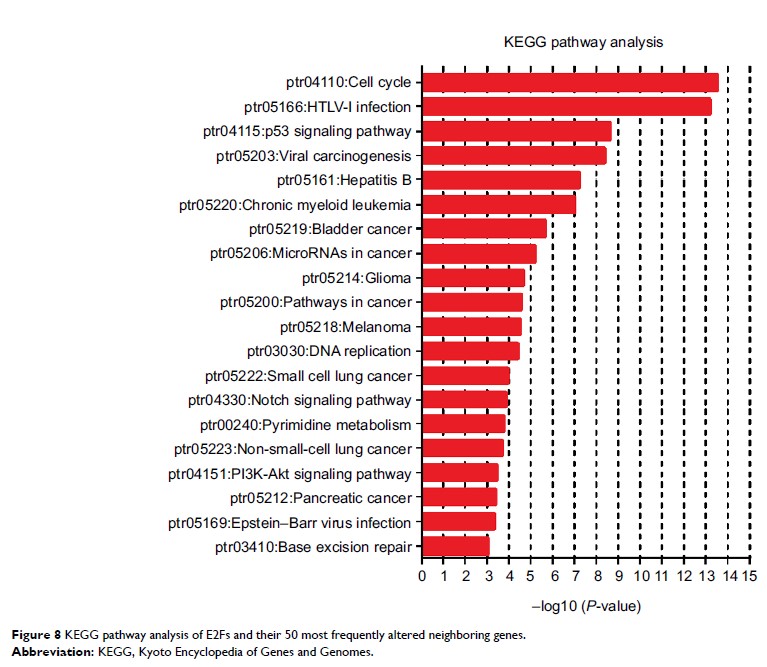108605
论文已发表
注册即可获取德孚的最新动态
IF 收录期刊
- 3.4 Breast Cancer (Dove Med Press)
- 3.2 Clin Epidemiol
- 2.6 Cancer Manag Res
- 2.9 Infect Drug Resist
- 3.7 Clin Interv Aging
- 5.1 Drug Des Dev Ther
- 3.1 Int J Chronic Obstr
- 6.6 Int J Nanomed
- 2.6 Int J Women's Health
- 2.9 Neuropsych Dis Treat
- 2.8 OncoTargets Ther
- 2.0 Patient Prefer Adher
- 2.2 Ther Clin Risk Manag
- 2.5 J Pain Res
- 3.0 Diabet Metab Synd Ob
- 3.2 Psychol Res Behav Ma
- 3.4 Nat Sci Sleep
- 1.8 Pharmgenomics Pers Med
- 2.0 Risk Manag Healthc Policy
- 4.1 J Inflamm Res
- 2.0 Int J Gen Med
- 3.4 J Hepatocell Carcinoma
- 3.0 J Asthma Allergy
- 2.2 Clin Cosmet Investig Dermatol
- 2.4 J Multidiscip Healthc

E2Fs 在人肝细胞癌中具有潜在的诊断价值和预后价值
Authors Huang Y, Ning G, Chen L, Lian Y, Gu Y, Wang J, Chen D, Wei H, Huang Y
Received 31 July 2018
Accepted for publication 13 January 2019
Published 19 February 2019 Volume 2019:11 Pages 1725—1740
DOI https://doi.org/10.2147/CMAR.S182001
Checked for plagiarism Yes
Review by Single-blind
Peer reviewers approved by Dr Amy Norman
Peer reviewer comments 2
Editor who approved publication: Professor Nakshatri
Background: A growing
body of evidence suggests that E2Fs, by regulating gene expression related to
cell cycle progression and other cellular processes, play a pivotal role in
human cancer. However, the distinct roles of each E2F in the development and
treatment of hepatocellular carcinoma (HCC) remain unknown. In the present
study, the mRNA expression and prognostic value of different E2Fs in HCC are
analyzed.
Materials and methods: Transcriptional
and survival data related to E2F expression in patients with HCC were obtained
through ONCOMINE and UALCAN databases. Survival analysis plots were drawn with
Kaplan–Meier Plotter. The sequence alteration data for E2Fs were obtained from
The Cancer Genome Atlas and c-BioPortal. Gene functional enrichment analyses
were performed in Database for Annotation, Visualization and Integrated
Discovery.
Results: The mRNA
expression levels of E2F1–E2F8 were all significantly upregulated in HCC
patients, and high expression of each E2F was obviously related to poor
prognosis. Similarly, the expression of E2Fs showed prognostic prediction value
in HCC patients with different cancer stages and pathological grades. Moreover,
the mutation rate of E2Fs was relatively high in HCC patients, and the DNA
sequence alterations primarily occurred in E2F5, E2F3, and E2F6, which were
associated with worse overall survival and disease-free survival in HCC
patients. Network analysis confirmed that the expression levels of cell
cycle-related genes were mostly affected by E2F mutations.
Conclusion: High
expression of individual E2Fs was associated with poor prognosis in all liver
cancer patients. E2Fs may be exploited as good prognostic targets for
comprehensive management of HCC patients, but this notion should be further
evaluated in clinical studies.
Keywords: HCC, E2F,
prognosis, ONCOMINE, Kaplan–Meier plotter
